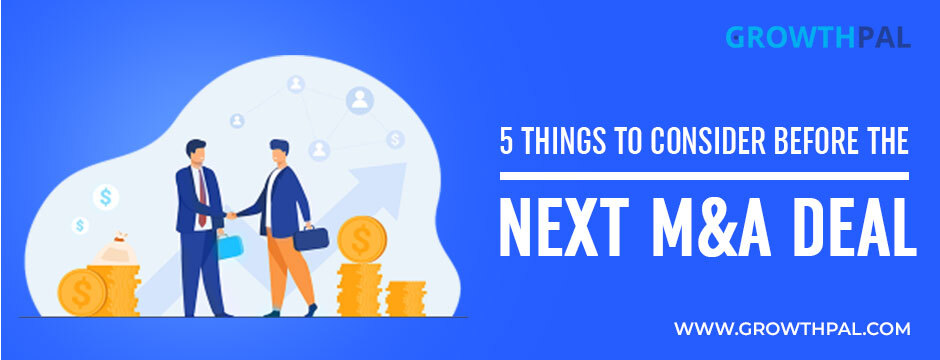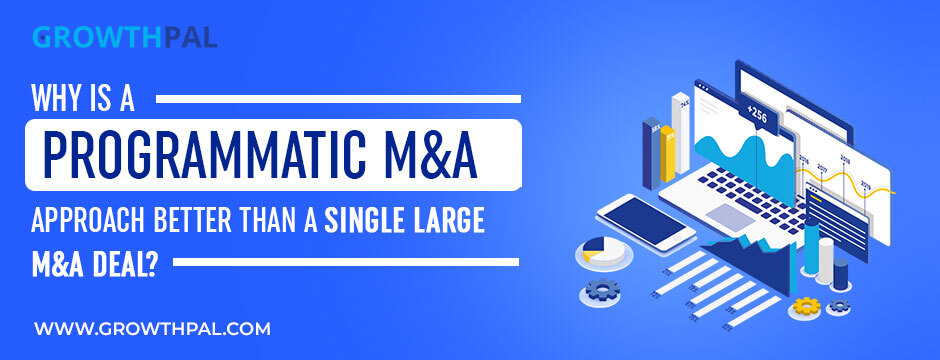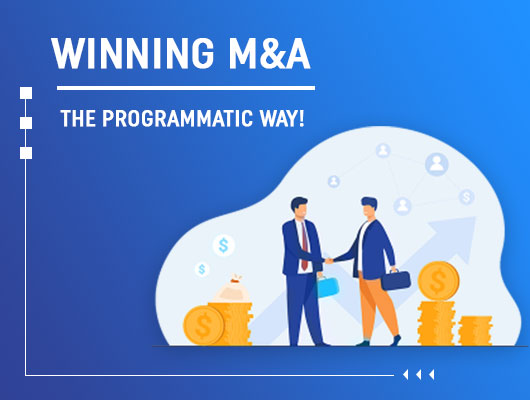Winning M&A - the programmatic way
Following the 2020 global pandemic, organizations are aligning toward the “new” reality. According to an EY analysis, global mergers and acquisitions (M&A) touched a record with deals worth more than $2.6 trillion in the first half of 2021. North America witnessed over half of these M&A transactions, with deals valued at $1.4 trillion. According to McKinsey, M&A deal values increased by 300% in the first half of 2021 as compared to the first half of 2020.
But here’s something noteworthy. Accenture analyzed over 800 M&A transactions globally. Of all these deals, only 27% were able to improve the operating margins of the involved companies, while only 5% achieved double-digit growth in revenues and operating margins.
While large-value deals continue to be mainstream, programmatic M&A strategies are now delivering better investment returns to shareholders (with lesser risk).
5 Things to Consider Before the Next M&A deal


Organizations need a long-term perspective to extract maximum value with their M&A deals. Here are five considerations for organizations before committing to their next merger or acquisition:
1. Effective Data Management
In today’s data-driven world, effective data management and integration are critical to a successful M&A across every industry. Sean Riley of Deloitte Transactions observes that “driving M&A transaction value often comes down to mitigating data-related risks, costs, and delays.”
With a well-designed data integration framework, companies can gain complete control of business data. By focusing on the required data, they can provide data access to employees quickly. Krishnan Ramachandran of Deloitte Transactions points out that in the quest for speedier transactions, “companies can get ahead of themselves and can leave value on the table.”
Along with data integration, organizations must devise their data management strategies under the prevailing legal and regulatory environment.
2. Cultural Fit
Organizational culture is an essential element in the success (or failure) of any M&A deal. A successful M&A transaction depends on a thriving organizational culture, including employee support and healthy interactions with the management team.
Companies often approach a merger or acquisition as an investment (without considering the overall business strategy). Before an acquisition or merger, buyers must include the “cultural fit” as one of the criteria requirements. This involves emphasizing key metrics related to:
- Risk management practices
- Employee satisfaction
- Employee hiring and retention
- Alignment with ESG principles
3. Strategic Alignment
McKinsey consultants Cristina Ferrer, Robert Uhlaner, and Andy West outline that “treating M&A as a strategic capability” can provide the companies with that edge that their peers would otherwise “struggle to replicate.” As it stands, corporate strategy is often one of the most overlooked elements of an effective M&A program. And among the major causes of an M&A failure is the mismatch between the corporate strategy and the acquisition (or merger).
In Henry Mintzberg’s classic book Strategic Safari, he points out that “strategy is about making choices, trade-offs; it’s about deliberately choosing to be different – you can’t be all things to all people.” In the case of M&A deals, this means that a company without a clear strategy would be willing to buy anything.
To complete their M&A integration process, companies often try to integrate every business element too quickly. This can put an additional burden on employees, thus risking higher attrition.
4. Customers
Organizations need an effective go-to-market (GTM) strategy before any M&A deal closure. A successful GTM strategy includes analyzing its target customers. Here, the question stems – Is the M&A strategy in line with understanding and meeting customer needs?
For any M&A deal, customer relationships are a critical reason for organizations to either merge or acquire to increase their market share. To avoid the common pitfalls, organizations must:
- Determine how this integration will impact customer actions and expectations
- Maintain an open line of communication between the business stakeholders and customers
5. Technology
Technology is crucial to the success of any M&A deal. According to an Accenture study, 74% of CEOs view technology as the source of organizational growth and competitive advantage. However, the same study found that only one in four CEOs are leveraging technology in their M&A deals.
Technologies like Artificial Intelligence (AI) and Machine Learning (ML) can accelerate the M&A process by saving time otherwise spent on manually going through various contracts. Here are some ways by which technology tools can create value in M&A processes:
- Identifying the right fit
- Delivering business value faster
- Achieving cybersecurity during M&A integration
The Accenture study outlines that 93% of CIOs agree that technology can accelerate their M&A initiatives. Over 80% of the outperforming M&A deals had executives emphasizing the use of technology.
How is Programmatic M&A a strategic game changer in any M&A deal? Let’s discuss that next.
Why Is a Programmatic M&A Approach Better Than a Single Large M&A Deal?


A study conducted by McKinsey outlined that the companies using programmatic M&A capability have witnessed success in reshaping their portfolios and surviving.
Programmatic M&A is based on the use of data and analytics to extend the reach of buyers. It drives the sourcing of targets from a large network of potential sellers and equips businesses to execute a number of small deals seamlessly. As such, the most striking advantage of programmatic M&A is the ability to build a robust and lasting pipeline of potential deals. This repeatability or “capability” is what gives it an edge over traditional M&A. A well-executed programmatic M&A strategy is both repeatable and scalable – characteristics that enable companies to build a sustainable and lasting growth engine.
The Bottom Line
Over the past two years, the pace of global M&A has increased exponentially across industry sectors. In the post-pandemic world, programmatic M&A is a “winning” strategy for most companies. However, companies do find it challenging to implement a successful programmatic M&A strategy for business success.
At GrowthPal, we have enabled companies to implement a successful M&A strategy that is based on intelligent analytics. By partnering with GrowthPal, you can design and implement a successful programmatic M&A pipeline and develop an effective M&A capability.
Want to know how? Connect with us today.









